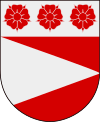Djursholm
| Djursholm | ||
|---|---|---|

|
||
|
||
| Coordinates: 59°23′50″N 18°05′15″E / 59.39722°N 18.08750°E | ||
| Country | Sweden | |
| Municipality | Danderyd Municipality | |
| County | ||
| Province | Uppland | |
| Charter | 1901 | |
| Time zone | CET (UTC+1) | |
| • Summer (DST) | CEST (UTC+2) | |
Djursholm (Swedish pronunciation: [jɵʂˈhɔlm]) is one of four suburban districts in, and the seat of Danderyd Municipality, , Sweden. Djursholm is included in the multi-municipal . Djursholm is divided into a number of different areas - Djursholms Ekeby (northwest), Svalnäs (northeast), Ösby (central), Berga (southwest) and Gamla Djursholm ('Old Djursholm', southeast).
Djursholm was one of the first suburban communities in Sweden, its history as such beginning in 1889 with the founding of Djursholm AB (Djursholm Inc.) by Henrik Palme and the subsequent 1890 inauguration of the railway line connecting Djursholm to Stockholm, Djursholmsbanan. Since 1895 it has been served by electric suburban trains but the original branch was closed in 1975.
Djursholm is the wealthiest community in Sweden, with the most expensive property prices in the country. It was built as a garden city with large villas, most from the turn of the century, along winding roads. Already from start the elegant seaside quarters attracted many well known academics, cultural personalities and industrialists.
Djursholm was separated from Danderyd as a municipality of its own in 1901, becoming a city (Djursholms stad) in 1914. In 1971 it was reunited with Danderyd when the present municipality was created. Statistically Djursholm lies within the .
Villa Lagerkrantz (Elis Benckert)
Villa Snellman (Gunnar Asplund)
Gamla Djursholm (Carl Westman)
Prinsvillan, Djursholm (Gustaf Hermansson)
Villa Mittag-Leffler (Ferdinand Boberg)
Djursholm Castle (Gustaf Banér)
Villa Lorride (Ernst Lundroth)
Djursholm Chapel (Fredrik Lilljekvist)
Coordinates: 59°23′50″N 18°05′15″E / 59.39722°N 18.08750°E
...
Wikipedia


